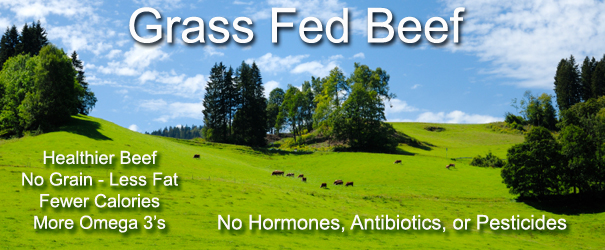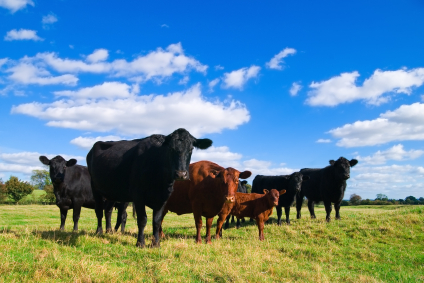 Loading... Please wait...
Loading... Please wait... Loading... Please wait...
Loading... Please wait...
When it comes to certified organic beef, there are a lot of things that people don’t understand. We’ll do our best to lay out the facts.
The need for organic beef started back in the 1950’s when conventional livestock producers started giving both natural & synthetic growth hormones to their cattle.
The main reason they did is so their cattle would eat more grains and corn. This would fatten them up faster and would then get them to the market quicker and as a result save them a lot of money and lower their costs. In 1955 McDonald’s opened their first franchise and as others joined them, lowering the cost of beef became even more valuable and competitive. It also became common for the producers to give their cattle antibiotics to keep the cattle “healthy” and avoid illness, as this too adds cost to production. This is not organic beef.
In the 1960’s a process or product known as mechanically separated meat became popular. This is basically a paste-like meat product that is made by forcing beef, pork, turkey, or chicken bones (with some meat on them) through a screen or sieve under high pressure. The paste (meat) goes through the screen while the bones remain on the other side; it’s kind of like wringing a towel out, except with a carcass. If you Google this topic, you will see pictures and videos (warning – it’s very gross). Because of the large amounts of bacteria this creates, the paste is then treated with large amounts of ammonia, yes, ammonia. Because the paste is now pink and tastes like ammonia, it is then treated with artificial flavoring and coloring. Finally, it is put into the food that we eat every day.
Another popular way processors bring down the cost of beef is by using meat fillers. Very similar to mechanically separated meat, the fillers also use ammonia to kill all the E. coli and salmonella. The “other ingredients” that “contribute to the moisture, consistency and quality” include; Ground beef, oat (wheat), silicon dioxide, ammonia, gluten (a binder), monosodium glutamate (known as MSG – cancerous), additives such as magnesium & calcium, scrap meat (eye balls, intestines). The FDA says that in order to be classified as meat, it must contain 40% ground beef, the rest can be meat fillers. Early in 2011 an Alabama based law firm, filed a class action suit against a popular fast food restaurant claiming its meat was only 35% beef.
In the late 80’s and early 90’s Genetically Modified Organism’s (GMO’s) received approval for large scale cultivation. This means that a large % of the feed traditional cattle receive today comes from something who’s DNA has been modified! If you can drastically reduce the cost of the feed for your cattle, this again means you can bring it to market at a lower cost. It’s all about making it faster and cheaper. Organic beef contains no GMO’s.
You may be wondering what this has to do with organic beef. Well, it’s really the whole reason why there was a need for farmers to start producing organic beef, people found out how the cattle were being raised and what was going into them. You add this to all of the crazy increases in disease in America and you wonder if there is a correlation.

With the arrival of the Organic label, many people assumed that if something was labeled all natural that it meant organic. There are strict regulations required to raise certified organic beef. However, the USDA defines “natural” beef as all meats raised for human consumption without additives and minimally processed. The U.S. Department of Agriculture allows any fresh meat to be described as “natural” if it includes no artificial flavoring, coloring, preservative or any other artificial ingredients. Minimally processed products, such as ground meat, also count as “natural.” So anyone who chooses to produce “natural beef” may choose not to use antibiotics or growth-promoting hormones, but there is no third-party verification system required by the USDA. That means that beef from factory feed lots can be labeled natural, according to the USDA’s definition. In addition, to be marketed as natural, it can’t contain any salt, or additives like monosodium glutamate.
We once had a major supplier who tried to sell us “all natural beef”. When we dug deeper about steroids and antibiotics, we were told there were no “unnatural” hormones or steroids in their beef. We asked more questions about what an unnatural hormone was only to find out that the cows were given a “natural” testosterone hormone implant on the cow’s ear to help them eat more. So their “All Natural Beef” product was raised in a feedlot, given a growth hormone, administered antibiotics, and fed GMO corn! They weren’t lying, according to the definitions given, they were being honest, but most people don’t dig deeper to learn what that actually means.
Organic requirements are much different than the “all natural” requirements. To be labeled certified organic, they must meet the following criteria:
• Born and raised on a certified organic pasture
• Never receive any antibiotics
• Never receive growth-promoting hormones
• Are fed only certified organic grains and grasses
• Must have unrestricted outdoor access
The philosophy is to provide the cows conditions that are similar to their natural environment. Thus, organic livestock are given access to the outdoors, fresh air, sunshine, water, grass and pasture, and are fed only 100% organic feed. If there is any shelter provided it must be designed to allow the animal comfort and the opportunity to exercise. Organic practices prohibit feeding animal parts of any kind to the cattle. Thus, no animal byproducts of any type are incorporated in organic feed at any time. In fact, in regular production, livestock can be fed plastic pellets for roughage, or given formulas that contain urea or manure.
In addition to the above requirements, national organic standards require oversight of the production and handling systems. So all production and handling of the product must undergo frequent onsite inspections to insure everything is up to organic beef standards. To read specific organic livestock requirements, including feed, health care practices, and living conditions, see: www.ams.usda.gov/nop/NOP/standards/prodhandreg.html.
All cattle eat a lot; this means that all cattle also make a lot of waste. Small farms use manure to naturally fertilize the soil. Industrial farms pollute with it. There are over 90 million head of cattle in the United States, and the vast majority of these live in huge feed lots where the waste has nowhere to go but down. It seeps into the groundwater, it finds its way into the river, it can contaminate wells with E. coli and other pathogens. In one region of NC, a hog farm produces 10 million metric tons of waste annually, that’s a lot of poop! In addition, the corn and grains that is used to feed non-organic beef, has been sprayed with pesticides that not only get into the cattle, but also harms our environment.
Mad cow disease is an illness also known as bovine spongiform encephalopathy (BSE for short). The disease affects a cow’s nervous system and brain causing the cow to act strangely and lose control of normal behaviors like walking. An infected cow would act “mad” or mentally ill (thus the name mad cow). We’ll get back to this in a minute.
In the non-organic beef farms, there is a practice of feeding cattle the ground up remains of their same species. In 1997 the FDA banned the feeding of cattle brain & spinal tissue. Although that is a good thing, they still allow the following materials to be fed to non-organic cattle:
• Gelatin (rendered from the hooves of cattle and other species)
• Fats, oils, grease, and tallow (from cattle and other species)
• Poultry and poultry by-products
• Rendered pork protein
• Rendered horse protein
Mad Cow Disease or BSE causes an infection in the cow. Most people think that the infection comes from this ground up animal by-product, especially the brains and spinal cords that may contain BSE. Of course when you buy organic meat, the animals are fed 100% organic feed without ground up animal parts. Many people buy organic meat as a way to safeguard against mad cow disease.
Imagine being in a small crowded room with nearly one hundred people. Many of these people may be sick, however, you cannot leave the room and you can’t really get very far away from the people who are sick. Well, imagine if you had to do this for about four months? That’s kind of what it is like to be a cow at a typical American feedlot. Most of the cow’s are on medication every day of their lives to try and prevent this. Many cattle ranchers who use feed lots (most of them do), have limited space resources, so packing the cattle together and forcing them to stand in their own excrement is common practice.
Not only does the average cattle rancher need to maximize their space, they need to minimize their time. What I mean by that is their goal is to get the cattle as big and fat as quickly as possible, and to make as much money as possible. Their whole goal is to speed up the growth process, they do this by feeding the cows grain diets with animal proteins added, sticking them with hormones & antibiotics. As a result the cows suffer from stress from adjusting to a new diet.
Overall, organically raised animals often have drastically better living conditions than animals raised in feedlots and commercial farms. They get unrestricted access to grassy pastures vs dirty feedlots.
In traditional feedlots and commercial farms, the cattle are fed a grain diet that has been grown with synthetic pesticides and fertilizers. Residues of persistent chemicals such as DDT, PCBs, dioxin, and many pesticides are known to concentrate in animal fat. With organic beef, the cattle are grazing in pastures that have not been treated with any pesticides or fertilizers. Eating organic beef reduces your exposure to these harmful chemicals.
Using no chemicals is also a benefit to the farmers. When you look at the research on people who work with pesticides and chemicals regularly, the death rates and ages are startling. Farmers working on organic farms are simply exposed to fewer chemicals. Organic agriculture works for a healthy balance of the soil, including using crop rotation and other techniques to improve soil fertility, instead of controlling the environment with chemicals.

Call us 480-799-2624
Copyright 2025 Topline Foods.